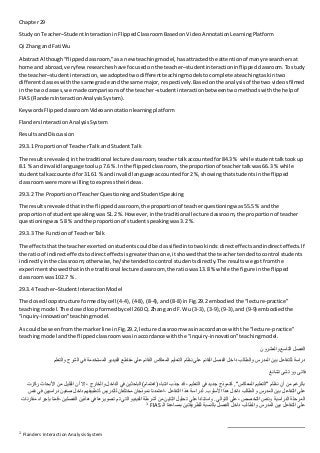
Study on Teacher–Student Interaction in Flipped Classroom Based on Video Annotation Learning Platform
- 1. Chapter29 Studyon Teacher–StudentInteractioninFlippedClassroomBasedonVideoAnnotationLearningPlatform Qi Zhangand Fati Wu AbstractAlthough“flippedclassroom,”asa newteachingmodel,hasattractedthe attentionof manyresearchersat home and abroad,veryfewresearcheshave focusedonthe teacher–studentinteractioninflippedclassroom.Tostudy the teacher–studentinteraction,we adoptedtwodifferentteachingmodelstocompleteateachingtaskintwo differentclasseswiththe same grade andthe same major,respectively.Basedonthe analysisof the twovideosfilmed inthe twoclasses,we made comparisonsof the teacher–studentinteractionbetweentwomethodswiththe helpof FIAS(FlandersInteractionAnalysisSystem). KeywordsFlipped classroomVideoannotationlearningplatform FlandersInteractionAnalysisSystem ResultsandDiscussion 29.3.1 Proportionof TeacherTalk andStudentTalk The resultsrevealed,inthe traditional lecture classroom,teachertalkaccountedfor84.3 % while studenttalktookup 8.1 % andinvalidlanguage tool up7.6 %.In the flippedclassroom, the proportionof teachertalkwas66.3 % while studenttalkaccountedfor31.61 % andinvalidlanguage accountedfor2%, showingthatstudentsinthe flipped classroomwere more willingtoexpresstheirideas. 29.3.2 The Proportionof TeacherQuestioningandStudentSpeaking The resultsrevealedthatinthe flippedclassroom, the proportionof teacherquestioningwas55.5 % andthe proportionof studentspeaking was51.2 %.However,inthe traditional lectureclassroom, the proportionof teacher questioningwas5.8 % and the proportionof studentspeakingwas3.2 %. 29.3.3 The Functionof TeacherTalk The effectsthatthe teacherexertedonstudentscouldbe classifiedintotwokinds:directeffectsandindirecteffects.If the ratio of indirecteffectstodirecteffectsisgreaterthanone,itshowedthatthe teachertendedtocontrol students indirectlyinthe classroom;otherwise,he/she tendedtocontrol studentsdirectly.The resultswe gotfromthe experimentshowedthatinthe traditional lectureclassroom, the ratiowas13.8 % while the figure inthe flipped classroomwas102.7 %. 29.3.4 Teacher–StudentInteractionModel The closedloopstructure formedby cell (4-4),(4-8),(8-4),and (8-8) in Fig.29.2 embodiedthe “lecture-practice” teachingmodel.The closedloopformedbycell 260 Q. Zhang andF. Wu (3-3), (3-9),(9-3),and (9-9) embodiedthe “inquiry-innovation”teachingmodel. As couldbe seenfromthe markerline inFig.29.2,lecture classroomwasinaccordance withthe “lecture-practice” teachingmodel andthe flippedclassroomwasinaccordance withthe “inquiry-innovation”teachingmodel. والعشرون التاسع الفصل داخل والطالب المدرس بين للتفاعل دراسةوالتعلم الشرح في المستخدمة الفيديو مقاطع علي القائم المعاكس التعليم نظام علي القائم الفصل فاتىووتشىتشانغ القلي أن ،إال والخارج الداخل في الباحثين )(اهتمام انتباه جذب قد ، التعليم في جديد كنموذج ,"المعاكس "التعليم نظام أن من بالرغمركزت األبحاث من ل ا عليفي دراسيين صفين داخل لتطبيقهم للتدريس مختلفان نموذجان ،اعتمدنا التفاعل هذا لدراسة .األسلوب هذا داخل والطالب المدرس بين لتفاعلنفس ،قمنا الفصلين هاذين في تصويرها تم التي الفيديو أشرطة من اثنتين تحليل علي واستنادا .التوالي ،علي التخصص ونفس الدراسية المرحلةبمقارنات إجراء الـ بمساعدة للطريقتين بالنسبة الفصل داخل والطالب المدرس بين التفاعل عليFIAS1 1 Flanders Interaction AnalysisSystem
- 2. والمناقشة النتائج 29–3.1الطالب وكالم المعلم كالم نسبة بنسبة الفصل داخل المدرس يتكلم التقليدية الدراسة أماكن في أنه النتائج كشفت8..1%د الطالب حديث وصل ،بينماإلي الفصل اخل8.3%نسبة ،وأما مثلت الهراء6.7%المدرس حديث نسبة ،كانت المعاكس التعليم لنظام بالنسبة أما .77.1%لنسبة الفصل الطالب كالم ارتفع ،بينما13.73%،ومثلت الفارغ الكالم نسبة2%للتعبير الرغبة لديهم المعاكس التعليم نظام داخل الطالب أن يعني ؛وهذا.التقليدي التعليم من أكثر وأفكارهم آرائهم عن 29/2.1الطالب وتفاعل المدرس أسئلة نسبة كانت المدرس أسئلة ،نسبة المعاكس التعليم نظام في أنه النتائج كشفن55.5%الطالب تفاعل ونسبة53.2%مثلت المدرس أسئلة نسبة أن من بالرغم . 5.8%بنسب كانت الطالب تفاعل ونسبةة1.2%.التقليدي التعليمي النظام داخل 29/1.1الطالب علي التأثير في المدرس كالم دور ا التأثيرات نسبة كانت فإذا .مباشرة غير تأثيرات ، مباشرة تأثيرات :نوعين إلي الفصل داخل المدرس يبذلها التي التأثيرات تصنيف يمكنأكبر مباشرة لغير المباشرة للتأثيرات بالنسبةيميل المدرس/ة أن ؛أي صحيح ،والعكس الفصل داخ مباشرة غير بطريقة الطالب توجيه إلي يميل المدرس أن يعني ،فهذا بمع التقليدي الفصل داخل المدرس كالم تأثير نسبة أن أوضحت التجربة هذه من عليها حصلنا التي فالنتائج .مباشرة بطريقة الطالب لتوجيهدل31.8% في الصورة بينمابمعدل المعاكس التعليم3.2.6%. 29/..1والطالب المدرس بين التفاعل عملية يوضح نموذج ( الخلية تشكلها التي المغلقة الحلقات.-.( ، ).-8( ، )8-.( ، )8-8الشكل في )2.29أما .للتدريس كنموذج "الممارسة علي القائمة "المحاضرة يجسد خلية تشكلها التي المغلقة الحلقات.27(وو فاتي و تشانغ تشي لـ1-1( ، )1-9( ، )9-1( ، )9-9"االبتكار تجسد )2 للتدريس كنموذج " الشكل في البارزة العالمة من يتضح وكما2.29مع يتماشى المعاكس ،والتعليم تدريسي كنموذج الممارسة علي القائم التعليم مع يتماشى التقليدي التعليم أن .تدريسي كنموذج االبتكار 2واالستفسار البحث علي أساسي بشكل معتمدة المحاضرة تكون أن